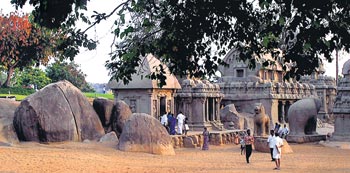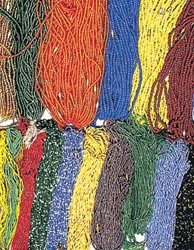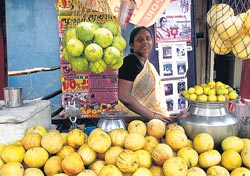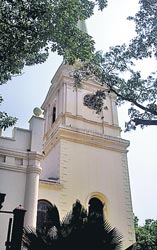
Checking out ChennaiOur destination was Chennai, formerly Madras. Chennai is India's fourth largest metropolitan city, located on the Coromandel coast of the Bay of Bengal. With an estimated population of 6.98 million (2006), it is the third largest commercial and industrial centre in India. The name Madras came from Madraspatnam, which was the site chosen by the British East India Company for a permanent settlement in 1639. South of this was a small town called Chennapatnam. These two towns were eventually merged, and the term Madras was favoured by the British as it was said to be of Portuguese origin. The locals had however, referred to it as Chennapatnam or Chennapuri so in August 1996, the city was renamed Chennai.
Arriving at the Chennai airport, we were taken in what I call a traditional Indian car, an ‘Ambassador,’ to the hotel, a half hour’s drive from the airport. Our destination was the rather grand Ambassador Pallava, on Montieth Road, which is about 18 km from the airport. This area is in the suburbs of Chennai and the famous Egmore Railway Station is just 15 minutes away from the hotel. Chennai is the capital of Tamil Nadu and known as the hub of South Indian classical music and dance. It is also considered the automobile capital of India. In fact a large percentage of the automobile industry has its bases in Chennai. It is also now known to be a major centre for outsourced jobs from the West. Food is in abundance in Chennai, starting from small roadside shops to big restaurants there is a variety available. South India is famous for strong coffee and ‘Café Coffee Day,’ just walking distance from our hotel, had various coffees and eats for reasonable prices. The best South India food we had was from, Hotel Saravana Bhavan. Like most places in Chennai, this too is a massive building bustling with customers waiting to get a seat. It is clean and there is a wide variety of vegetarian food on offer. An average meal for two costs around Rs. 150. However, if South Indian is not your pick, there is still a choice of Continental, Chinese or Thai cuisine. Always remember to be careful with water. There are some reputed brands of bottled water which can be purchased in supermarkets and stores in the city.
Shopping in Chennai, is not like shopping here… there is just a whole range to choose from and there is just an abundance of everything. Therefore, lots of time and patience is needed, or may I say, is a requirement, while shopping! Spencer Plaza, a massive complex, has heaps of shops which have everything to offer from cosmetics, to clothes, to accessories to electronic appliances to food… just to name a few! Apart from Spencer Plaza, also in the area, you will find a relatively exclusive store called ‘Fab India’, similar to ‘Barefoot’ in concept. The clothes are of bright colours and there is a wide selection to be purchased. Chennai, from what I noticed, is one place where you can bargain, starting from the ‘auto’ fare to clothes and accessories. Chennai has heaps of places on the roadside where you can pick up accessories. I found Mylapore, the best place for bangles, chains and bindhis. When you think India, you think sarees. Chennai is known for silk sarees and T Nagar had a number of massive saree stores. We visited ‘Saravana Stores,’ which is a huge store full of sarees and other clothing items like shalwars and kurthas. Just walking into the place, the size overwhelms you, but the prices are reasonable, the staff are helpful and do not hesitate to pull out every single saree and help you choose the best one. When it comes to sightseeing, there are a number of places to see. On our first day of sightseeing we were taken to the famous Santhome Cathedral Basilica, a Roman Catholic cathedral built in the 16th Century by Portuguese explorers. It had been rebuilt again by the British in 1893 and this is what can be seen today. It was supposed to have been built over the tomb of the apostle St. Thomas, one of Jesus’s 12 apostles, who preached in Chennai between 52 and 72 AD and was killed here. The place is a pilgrimage centre for Christians in India.
Mylapore is one of the oldest areas in Chennai and a place of interest which we visitedhere was the Kapaleeswarar Temple, with its beautiful temple tank. The temple had been built in the 8th Century by the Pallavas. The legend behind the temple is said to be that the Goddess Parvathi, (said to be the divine consort of Lord Shiva), had done penance at Mylapore by taking the form of a pea-hen. This was done so she could be wedded to him. In addition, the name ‘Mylapore’ is derived from a legend, where the word, ‘Myil’ in Tamil means peacock. The present temple was built 300-400 years ago as it was destroyed by the Portuguese. The previous location was said to have been by the sea shore. Chennai also has a national park, within its city limits, the Guindy National Park. The city being close to the coast, another place you may want to visit is the Marina Beach. Another place of interest is Fort St. George. With the arrival of the Portuguese in 1522, a port was built, and named after St. Thomas as São Tomé. On August 22, 1639, the British East India Company obtained a small piece of land to build a factory and warehouse for trading activities. Fort St. George, was built a year later and this was the centre of which the colonial city grew. Fort St. George along with Madras were captured by the French. Today, the Anglican St. Mary’s Church can be seen in the premises of the fort. The large church organ, the Prayer Chapel (a place where those of all faiths are welcome to spend a few moments in prayer) can be seen in the church along with a number of tombs outside the church and inside it as well.
Interestingly Elihu Yale, the governor of Fort St. George, at the time, who gave his name to the Yale University in the United States has the first marriage entry in the church marriage register. Travelling towards the East Coast, about 21 km south of Chennai, on the coastal road is DakshinaChitra, in Muttukadu. Here, you can get the feel of the living traditions of art, folk performing arts, craft and architecture of India with the emphasis on South India – Tamil Nadu, Kerala, Andhra Pradesh and Karnataka. The architecture of the houses here is very similar to the traditional houses in Sri Lanka. Our next destination was the famous Mahabalipuram. This town in Kancheepuram is around 60 km south of Chennai and was a 7th Century port city of the South Indian dynasty of the Pallavas, named after the Pallava king Mamalla. A UNESCO World Heritage Site, the monuments built here, rock-cut and monolithi, date back to between the 7th and 9th Century. Early stages of Dravidian architecture can be seen and therefore Buddhist elements of design are prominent. There are cave temples, monolithic rathas (chariots), sculpted reliefs and structural temples. The stone pillars which can be seen, even today are of the Dravidian order and the sculptures are an example of Pallava art. This area is known for its granite and it is believed by some that this area served as a school for young sculptors. There are different sculptures, some of which are incomplete. These are believed to have been examples of different styles of architecture, which may have been demonstrated by instructors and then in turn, practised by students. Descent of the Ganges which is a giant open-air bas relief, Arjuna's Penance, a relief sculpture which presents an episode from The Mahabharata, the Pancha Rathas (Five Chariots), five monolithic pyramidal structures named after the Pandavas (Arjuna, Bhima, Yudhishtra, Nakula and Sahadeva) and Draupadi and carved from one single large piece of stone are some of the main attractions. There is a small rock-cut temple called the Varaha Cave Temple dating back to the 7th Century. The Shore Temple which is along the Bay of Bengal has its entrance from the western side away from the sea. There were said to be a few other temples in the area but they have been lost to the sea. There are a number of little shops near the ‘Pancha Rathas’ and walking on the beach stretch by the Shore Temple you can shop for a number of souvenirs. Leaving Chennai and coming into Sri Lanka, looking out of my plane shutter, I realised that even though there are clear cut differences, in the past our cultures had been very similar. It hit me that these 30 miles ( connected by Adam’s Bridge) between Mannar in Sri Lanka and Rameswaram on the southern coast of India, geographically, is all that seperates our small island nation from this giant landmass. |
|| Front
Page | News | Editorial | Columns | Sports | Plus | Financial
Times | International | Mirror | TV
Times | Funday
Times || |
| |
Copyright
2007 Wijeya
Newspapers Ltd.Colombo. Sri Lanka. |



